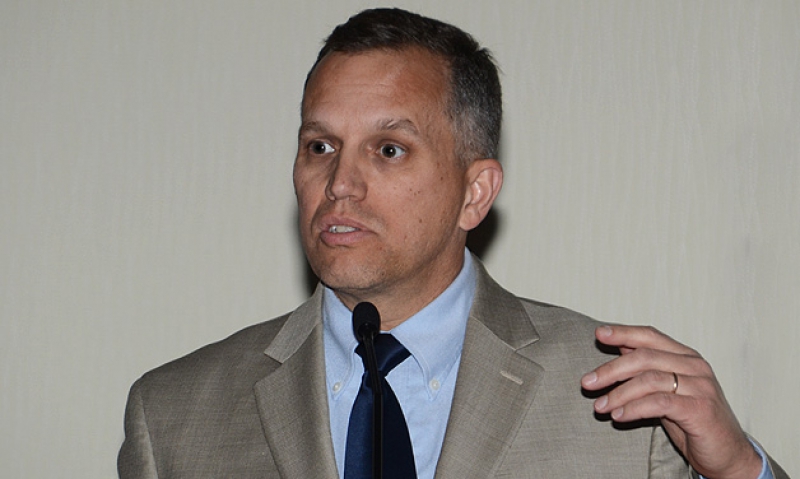
Legion receives VA briefing
The American Legion’s National Commission on Veterans Affairs & Rehabilitation heard presentations by several speakers from the Department of Veterans Affairs (VA) at its Feb. 27 meeting during the Washington Conference.
Speakers at the briefing included Steve Muro, under secretary for memorial affairs in the National Cemetery Administration (NCA); Allison Hickey, under secretary for benefits in the Veterans Benefits Administration (VBA); and Joe Paiva, executive director of VA's Virtual Lifetime Electronic Records (VLER) program.
Muro briefed Legionnaires on NCA’s mission, which is to provide dignified resting places for veterans, as well as eligible dependents and spouses, at more than 130 national cemeteries. "We have only one chance to get it right," Muro said.
A new product available to families from NCA is a special bronze medallion that can be placed on headstones in private cemeteries to designate veteran status of the deceased. Under the fiscal 2013 budget request, NCA has the authority to provide such medallions for any veteran buried with a non-government headstone.
Presidential memorial certificates are also given to family members of any deceased veteran who had an honorable discharge from active duty.
Muro noted that the only benefit many veterans get is the U.S. flag at their funeral service.
"So we need your help to get out there and find those veterans that haven’t come to us, to have them come to you so they can learn about their benefits — so their families can learn about the benefits," Muro said.
Hickey, a retired Air Force veteran, talked about VA’s backlog of disability compensation claims, "the big elephant in the middle of our room. It’s important for us to find solutions, and I think we have some good ones coming forward — not, by the way, on our own, but with lots of great help from you."
Since 2008, VBA’s budget has increased by 36 percent and it now serves 11.7 million veterans. For the second year in a row, VBA has completed more than a million disability claims. "We didn’t do that by ourselves, we did that with your help and your service officers that are out there every single day, helping us put together those (claims) packages," Hickey said. "That’s 16 percent more claims per year than in 2008.
"In addition, we’re getting more Vet Success on Campus folks out there, putting them in places where our student veterans are, so they can help them with transition adjustment, adaptation, even just help working the system for things like claims and medical appointments."
VA took another big step in eliminating homelessness among the veterans population. "There’s 73,000 veterans and their families or survivors that are under roof today, that may not have been except for us intervening, and us working and us re-doing loans and working with them to mitigate any impact they had in their lives," Hickey said. "And we do that every single day."
Hickey said VA wants more help in getting the word out that it can help any veteran with home financing problems, even if their loans aren’t through VA. Veterans struggling to stay in their homes can call upon the VA for help at any time.
The executive director of VA’s Virtual Lifetime Electronic Records (VLER) initiative, Joe Paiva, briefed Legionnaires on the program’s progress and outlook for the near future. He described VLER as the "logistics and artillery" that helps VBA’s "infantry" get the job done.
Paiva said VLER, which was created to provide servicemembers with DoD/VA-compatible medical records, "is an effort that is largely misunderstood, It’s misrepresented in the press all the time. There are a lot of people who do not understand what it’s about."
While the sharing of GI health records with a variety of federal agencies is an important goal, Paiva said "VLER is about the proactive delivery of a full continuum of services and benefits that veterans have earned — not just by VA, but by VA and its partners."
Currently, the documentation of some disability claims presents a difficult challenge to VA and VSOs alike, Paiva said, especially if a combat mission was classified or happened a long time ago. Medical records and orders have to be located, and sometimes they never existed to begin with, or have been destroyed.
With VLER in place, an electronic medical record would be created whenever a service-connected injury was being treated. All such records would remain linked to the servicemember for VA and DoD to access freely.
When it came time for an individual to leave active duty or retire, DoD would automatically notify VA, and the servicemember would be notified by VA to fill out a one-time form needed to transfer his or her medical records. All this would be done before a servicemember ever left active duty, Paiva said.
"Then the whole process would be proactive, it would be the VA reaching out. And there are technologies that exist today that allow us to do that," Paiva said. "What we want to do is have the same type of relationship with military members, from the day they join the service until the final benefit is administered. And modern technology lets us do that.
"There’s no such thing as a spontaneous veteran. I can tell you how many veterans we’re going to have four years from now, today. All I have to do is go and look at all the people in the military — 80 percent of them are going to be veterans." So VA needs to engage with veterans early in their careers and throughout their lives "because we don’t fight wars the way we used to," Paiva added "We don’t conscript people for two years and then it’s over, right?
"We have people that voluntarily join the military, and they have a relationship with the military that lasts the rest of their lives. So the idea is to use technology to honor that relationship and cultivate that relationship from day one. That’s what VLER’s about."
